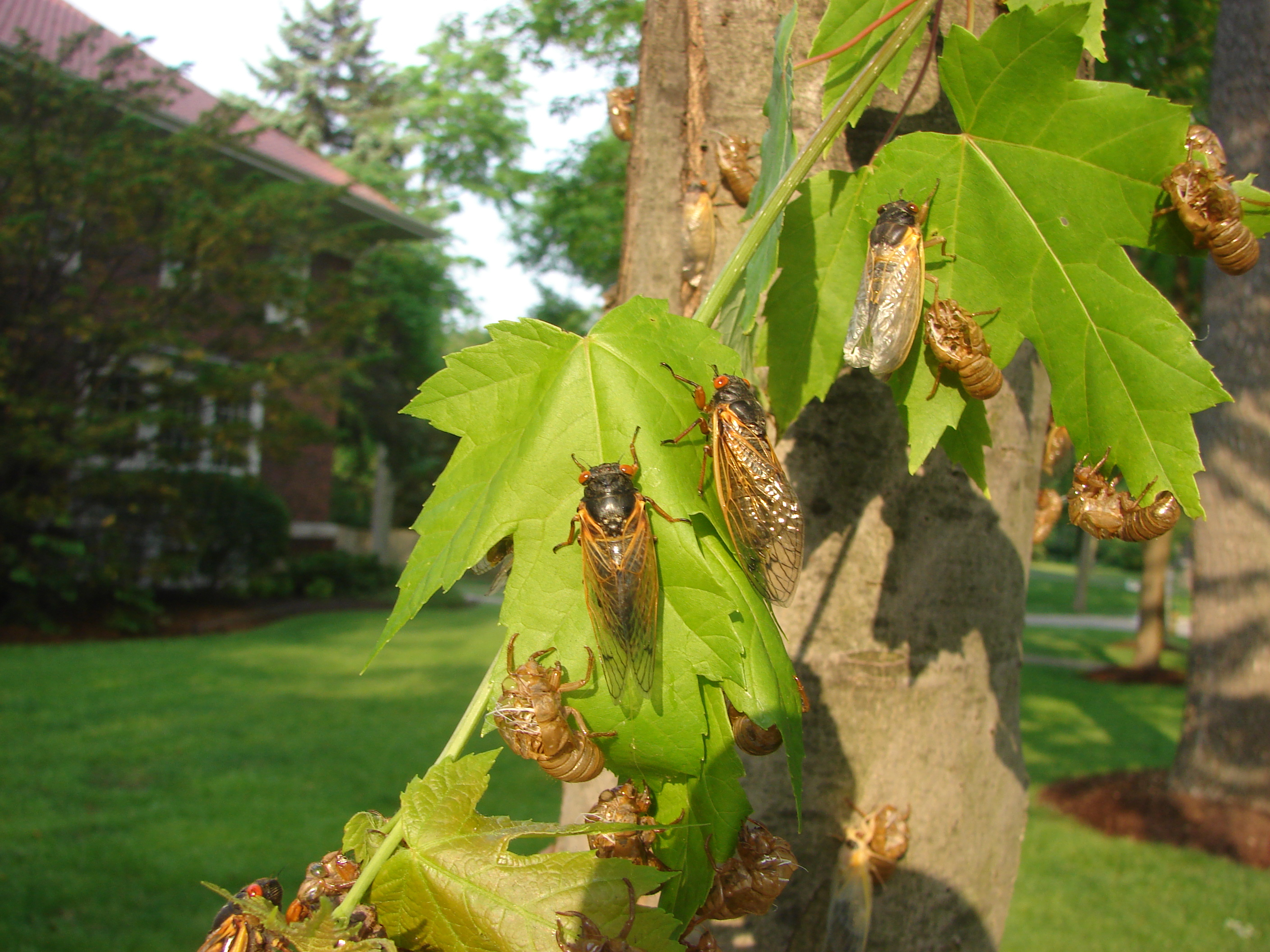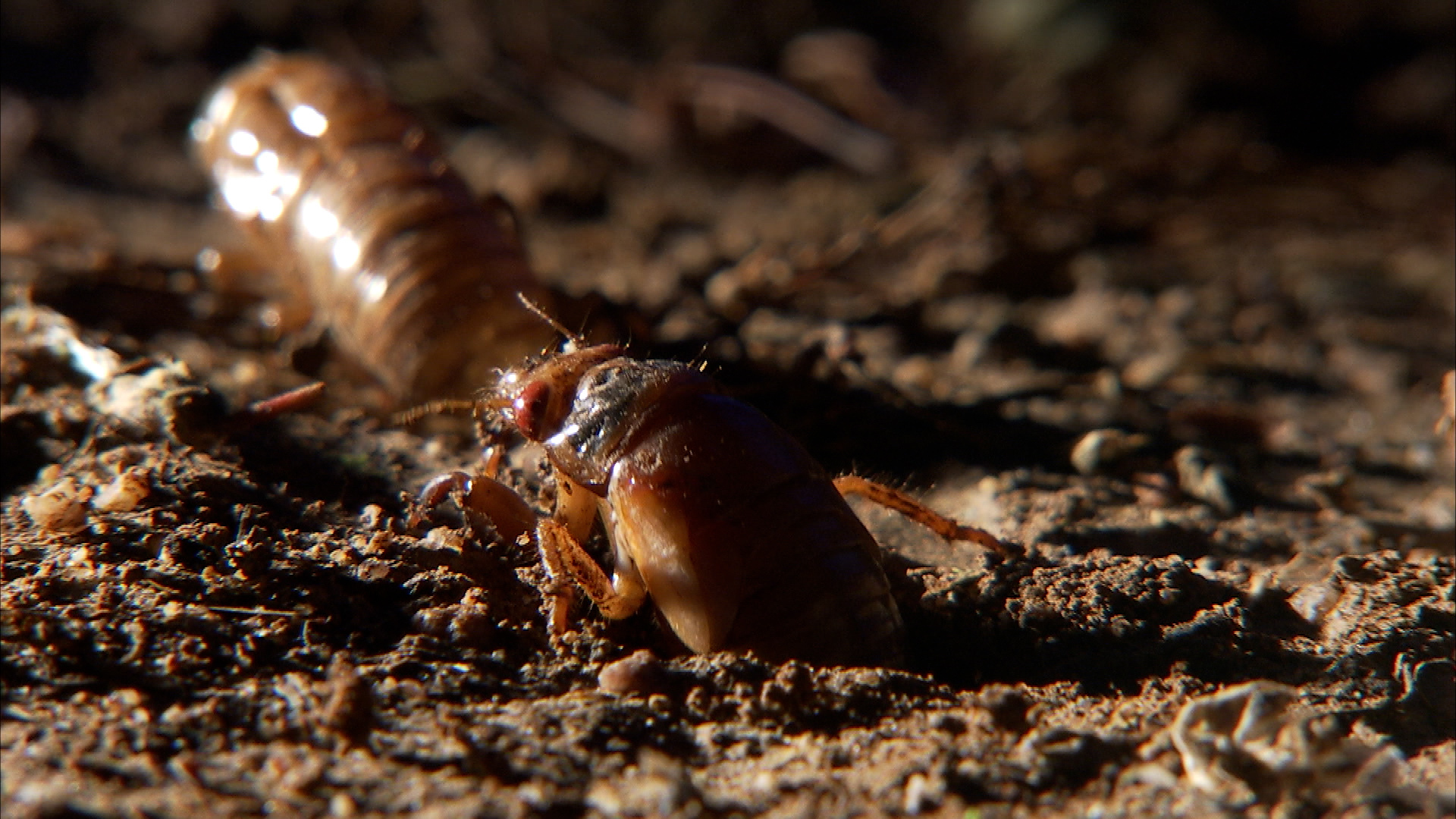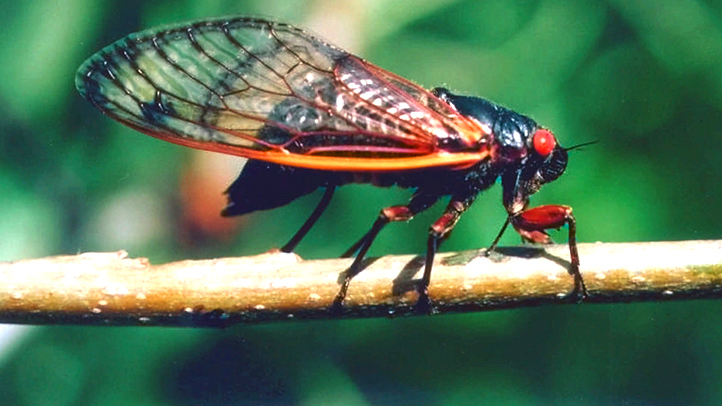If you don't mind cicadas, you might not notice when billions of them come crawling up from the ground this spring and summer in Illinois as part of a rare event that hasn't occurred for over 200 years.
If you aren't really a fan of the big-eyed bugs though, you might want to stay inside. According to experts, they're going to be "everywhere."
"There's no stopping them," Allen Lawrance, associate curator of entomology at the Peggy Notebaert Nature Museum in Chicago said. "They're here. It's temporary, and there's really no escaping them."
Some experts say you might however be able to limit the number of them in your yard.
For the past 17 years, billions of periodical cicada spawn from Brood XIII have been living underground in the Chicago area, tapping into fluid from plant roots. In late May and June, the nymphs from that Brood will burrow up from the ground and head to trees and wooded areas for approximately four to six weeks, where they'll mate, lay eggs and sing.
"You're just going to see them sort of flying around, hanging out on trees," Lawrance said. "And you're going to hear them wherever you go."
According to experts, the cicadas are a good thing for the ecosystem. They are a valuable source of food for insects, birds and other predators, and they can help aerate lawns. The Environmental Protection Agency notes cicadas are a good source of compost, providing nutrients to the soil as they decompose.
"All the animals that are around when they emerge are going to be very full and happy," Lawrance said. "Plants are going to get a boost in fertilizer for a little bit...when we have extreme weather events, like a drought, that cicada emergence happens at the right time that can provide a really valuable food source when nutrients are very scarce."
Still, there's going to be a lot of them, Lawrance said, especially on and around trees, where "piles" of cicada shells can are expected after the insects have "feasted" on fluid from branches and woody shrubs. One article from the University of Illinois Extension stated that Brood XIX, set to emerge in late May 2024, has a reputation for being the "largest emergence of cicadas known anywhere," due to the brood's size.
Feeling out of the loop? We'll catch you up on the Chicago news you need to know. Sign up for the weekly Chicago Catch-Up newsletter here.
So what exactly are Illinois residents supposed to do about the takeover? Not much, experts say. And the same goes for exterminators.
Do pesticides work on cicadas?
Frank Meek, a technical services manager at pest control company Orkin told NBC Chicago exterminators don't typically treat cicadas because they aren't a threat to humans, animals or property.
In addition, chemical treatments are generally ineffective against cicadas because of their short lifespan, Meek added.
"Cicadas are an important part of the food chain, and serve as meals for birds, moles, raccoons, and some frogs," Meek said. "It’s important for humans to leave cicadas alone so other animals can benefit from the food source."
Cicadas aren't considered pests, Meek said. But they have been known to fly into homes uninvited.
"Cicadas are strong but clumsy fliers and can accidentally fly into homes if windows and doors are left open," Meek said. "However, because cicadas cannot breed indoors, an infestation indoors cannot occur."
MAP: A map of where to expect cicadas in 2024 and which broods will hit Illinois
According to Meek, cicadas found in yards and gardens can be "gently" removed by hand. And though Orkin doesn't advise pest treatment around homes for cicadas, there is one extra layer of defense homeowners can take to keep cicadas further away, the company says.
"Homeowners can also prevent cicadas from making a home in their trees and bushes by wrapping the base in foil or barrier tape," Meek said. "This prevents cicadas from moving up the tree or bush to feed or lay eggs."
Still, experts say, it might not be worth the trouble. After all, there will be billions of them.
"You should definitely not try to remove them from an area with billions," Lawrance said, adding that cicadas will get composted back into the soil on their own.
Are cicadas harmful at all?
According to Lawrance, what characterizes a cicada brood is the year they emerge. Some are louder than others, but one brood isn't more harmful, dangerous or aggressive than another.
Brood XIII will emerge "all across Northern Illinois," while Brood XIX will be in the southern part of the state, Lawrance said, with some parts of the state seeing both. And while the Chicago area Brood may be more noisy, it won't cause much damage, Lawrance said.
MORE: Do cicadas bite or sting? ‘Billions' of cicadas soon emerging in Illinois are ‘really chill'
"There's really no harm to them," Lawrance said. "These cicadas -- their life strategy is just, anything can eat them, and enough will survive. They have no defensive behaviors whatsoever. So they really won't even fly away from you when you walk up to them. They just kind of stay put and hang around. They're really chill."
They're safe for dogs to eat in moderation, too Lawrance said. Though they are safe for humans to eat, Lawrance advises those with shellfish allergies to steer clear.
"Oftentimes that allergy, what can be causing that would be the in the exoskeleton," Lawrance said. "And insects have that as well. So definitely I would avoid them if you have a shellfish allergy. Just by touching them, I don't think they should cause any problems."
They could, however, cause problems for young trees.
"The leaves at the tip of the twig may turn brown and hang down, flagging," Lawrance said." That flagging won't cause any serious health damage to the tree unless it is a very young tree planted in orchards."
A post from the City of Lake Forest advised residents planting young trees this spring to cover them with netting. They added that using contact insecticides is not recommended, as the insects are beneficial.
"Enjoy this natural phenomenon," the city said. "Cicadas don’t bite or sting, and they aren’t poisonous."
How loud will it actually be?
Brood XIII specifically, which will primarily be in the Chicago area, is expected to be a "pretty loud one."
"Think of it like a chorus," Lawrance said. "The more voices you have, the louder the sound. And this brood that emerges in Chicago is known to be a pretty dense group."
"During the 1956 emergence, [epidemiologists] counted an average of 311 nymphal emergence holes per square yard of ground in a forested floodplain near Chicago," the article said. "This translates to 1½ million cicadas per acre. In upland sites, they recorded 27 emergence holes per square yard, translating to about 133,000 per acre."
According to Lawrance, the "singing" — a form of communication, and a mating call — from such a large group will sound like an "endless hum."
"You may just want to enjoy the music the cicada chorus creates," Meek said.
What are the cicadas doing underground?
After they emerge this spring and summer, female periodical cicadas will lay their eggs on the tips of tree branches. Eventually, those eggs will hatch and drop down into the soil, Lawrance said. The nymphs then burrow underground, and their 17-year cycle of life begins again.
How and when they emerge in such a harmonious way, though, is a bit of a puzzle.
"That's kind of a big mystery," Lawrance said. "How are they so synchronized to do this? At the same time? There seems to be something that's genetically or physiologically controlled, so they just know instinctually to do this."
And once they burrow up, there's "really no escaping them," Lawrance said, especially on and around trees, where "piles" of cicada shells can are expected after the insects have feasted on fluid from branches and woody shrubs.
That is, until they die and get composted back into the ground. Or get eaten.
"Everything eats them," Lawrance said. "The periodical cicadas' 'life strategy' is by emerging all at once. Everything that eats them can eat as many as they want, and there are still more than enough cicadas left behind to continue the population."
Periodical cicadas, Lawrance said, are a "petty tasty snack" to squirrels, birds or snakes. Dogs can eat them too, Lawrance added, in moderation.
"As far as insects go, they're very large and meaty," Lawrance said. "They have a lot of nutrients there."
Which areas will see the most?
According to Lawrance, the cicada distribution will be patchy.
"Not every neighborhood is going to be as dense with them as others," he said. "One area may be slightly more quiet, and you'll hear them in the distance. And then you go to the next neighborhood, and it's hoppin', and they're everywhere."
There is one determining factor, however: If they were there before, they'll be there again.
"So, which neighborhoods you would expect to find them in will depend on where they were last time they emerged," Lawrance said. "If the soil had been completely dug up and replaced due to construction, there may be fewer cicadas there. But if they were there last time, chances are, they'll still be there."
The same goes for the next 17 years.
'There's no stopping them'
According to the Environmental Protection Agency, pesticides are "generally ineffective at keeping cicadas away."
"So many cicadas emerge at once that more will inevitably move in," the agency said. "Spraying also doesn’t make sense because cicadas are generally harmless. Applying pesticides to control cicadas may harm other organisms, including animals that eat cicadas."
With such a large number, there will be nowhere to run come June, Lawrance stressed.
"There's no stopping them. They're here. It's temporary, and there's really no escaping them," he said.
And though some may not look forward to the bug invasion, the phenomenon can still be experienced -- or listened to -- from afar, Lawrance offered.
"It's just really a unique experience," Lawrance said. "A good gateway to learning how to appreciate them is to start with that music that they make so you can hear them. It's kind of like learning to appreciate an orchestral piece. We have multiple species that each have different songs as well. So throughout time you just start to listen and say, 'Oh, that one sounds a little bit different. I wonder what that is.' And then you can start to appreciate them without having to get too close and getting grossed out by them."




